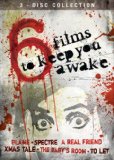| Reviews & Columns |
|
Reviews DVD TV on DVD Blu-ray 4K UHD International DVDs In Theaters Reviews by Studio Video Games Features Collector Series DVDs Easter Egg Database Interviews DVD Talk Radio Feature Articles Columns Anime Talk DVD Savant Horror DVDs The M.O.D. Squad Art House HD Talk Silent DVD
|
DVD Talk Forum |
|
|
| Resources |
|
DVD Price Search Customer Service #'s RCE Info Links |
|
Columns
|
|
|
6 Films to Keep You Awake
Lionsgate Home Entertainment // Unrated // August 19, 2008
List Price: $27.98 [Buy now and save at Amazon]
6 Films to Keep You Awake, or Peliculas para no Dormir (Movies for no Sleep), is pretty close to Spain's version of the Masters of Horror series or something akin to an adult hybrid of Nickelodeon's "Are You Afraid of the Dark" and "The Twilight Zone". It's a collection of six eerie tales, each of them a little over an hour long in length, which take on the clear objective to be a short roller coaster of chills and gore. Much like any collection of films concocted by different directors for a package deal, these 6 Films to Keep You Awake vary in effectiveness and entertainment value. However, the singular fact that covers all six is that they're all competently crafted and, at least to some small degree, reasonably unnerving.
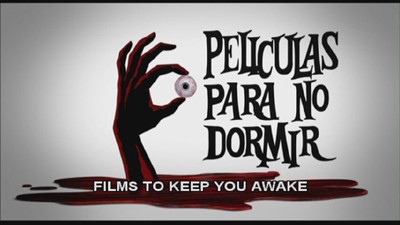
Most of these six short films revolve around a specific kind of tension that evokes around household, or localized, terror. It makes perfect sense, especially when you take into account that the Films to Keep You Awake was originally aired as a television series. Each film's primary goal lies in making you feel like something eerie is looming around each corner of either your home or somewhere nearby. Just think of the television set as a digital campfire and the speakers of your home theater as the voice of six different storytellers. Lions Gate has brought this collection to us in a very efficient package, cutting elaborate production corners in an effort to craft a loaded, lower-priced set that will be perfect for horror film enthusiasts and completists.
The "Peliculas Para No Dormir":
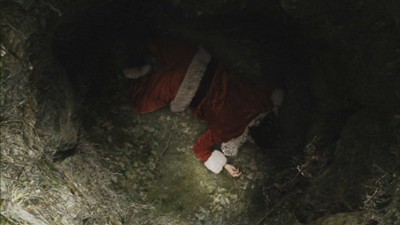
A Christmas Tale (Cuento de Natividad)
Directed by: Paco Plaza
Featuring Ivana Baquero in one of her first feature roles before becoming a minor starlet in Guillermo Del Toro's Pan's Labyrinth, A Christmas Tale reflects the charm of child-based adventure horror flicks like Monster Squad and The Goonies in a darker light. After discovering the body of a dirty woman adorned in a Santa suit, the focal group of unique little children decides to keep her in that hole -- making a pact to sustain her as their "pet". They learn, however, that she is a dangerous thief who has harbored a great sum of money at an undisclosed location. As greed and morbidity start to creep into some of the children's minds, they fight between themselves to decide exactly how to handle their prisoner. It's only once they start to bite furiously at each other that they discover that their tortured prisoner has discovered a way out.
Paco Plaza's gripping little moral piece keeps a steady level of tension as the anger raging within the captured woman grows, which forms an interesting dynamic that almost wants the viewer to wish her release so that she can get a hold of the kids -- at least, the nasty ones. Each of the young actors piece together interesting little performances, especially the two evil boys. Most unique, however, is one of the more interesting villains I've seen in the evil thieving Santa-dressed woman. She becomes an ominous presence once A Christmas Tale transforms into a cat-and-mouse type of horror film, one that can be strangely rooted for and dangerous in equal strides. As the compelling twist jerks the film in a gripping direction near the end, the spliced images of a tarnished "zombie" film interlaced into A Christmas Tale come to snarky fruition. It might not be the best film in the series, but it undoubtedly has my favorite monstrous villain from the line-up. -- (3.5 / 5)
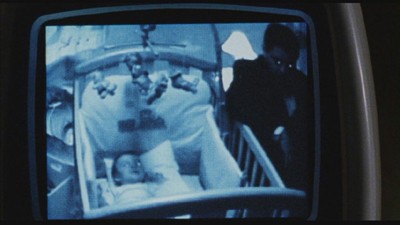
The Baby's Room (La Habitacion del Nino)
Directed by: Alexa de la Iglesia
Fitting in somewhere between the tech thriller Frequency and the Spanish horror masterwork The Orphanage, The Baby's Room indulges in an effective connection involving a haunted house and a technological abnormality that allows vision into an alternate universe. After an old baby monitor picks up some odd disturbance in the middle of the night that sounds like voices, Juan seeks a more advanced method of monitoring him and his wife Sonia's child during sleep. He comes home with the most advanced form of monitoring device with all the video surveillance bells and whistles, including infrared vision and a battery-operated screen. After they believe all their problems are solved, Juan spots something so frightening in the monitor that it sparks a downward spiral into insanity.
Perhaps the strongest flick of the bunch, The Baby's Room evokes a strong level of tension by peeking into the dangerous unknown by our modern technology. Along the way, it also tinkers with the properties of metaphysical reality and philosophical sciences. Somehow, Alexa de la Iglesia's film blends these two elements into an even stronger and oddly thoughtful pathway that leads straight into the unknown. Curiosity, insanity, and fear all come to a junction in its abyssal third act, one that'll really get your goosebumps going. Substantial performances and the fantastic architecture of this simple yet chilling ghost story barrel along to a whopper of a conclusion, one that'll really keep your head scratching once it makes sense -- well, at least as much sense as it can make. -- (3.5 / 5)
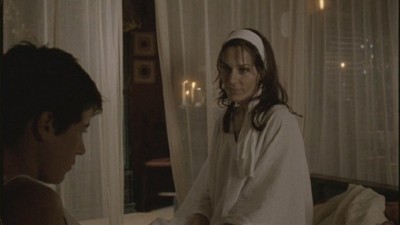
Spectre (Regreso a Moira)
Directed by: Mateo Gil
Imagine Cinema Paradiso ... only instead of an aged man returning to a movie theater from his past, he returns to try and find a hell-bent witch that he had an affair with when he was a teenager. That's Spectre, a somewhat well-performed mystery drama filled with spooky mannerisms within its dusty sepia photography. It focuses on Tomas' memories of him and two of his friends as they decide to go and spy on the local harlot Moira, a sumptuous woman believed to be a bewitching mystic. Through chance and understanding of her questionable background, Tomas somehow ends up twirling together with the shunned woman in a torrid affair. But when the townspeople's anger begins to grow and jealousy rustles between the boys as Tomas distances himself further from his town, tempers and curiosities flare up into a heated conflict.
As a fan of Asian horror, I'm accustomed to the supernatural drama flavor of film; bearing that in mind, Mateo Gil's Spectre isn't half bad. It twiddles around with the discomfort of a young boy playing with an older woman, as well as his uncertainty regarding her "magical" gift. She leaves the nights open for her witchy activities, which become the focal eerie subject that drives Tomas mad. But there's a lot of weighty build-up to Spectre's conclusion, all of which leaves you waiting to see where the horror elements will really kick into gear in this pseudo-passionate story that's supposed to "keep you awake" with the promise of a ghastly figure. When these elements arise, they're fairly anticlimactic and deflate a lot of the creepiness with their nonsensicalities -- though, they're both still a sustaining yet odd wrap-up to a competently conducted ghost story. The story's title itself instills the idea of a spectre, yet we only see that element unravel in its final dizzying moments. -- (3 / 5)
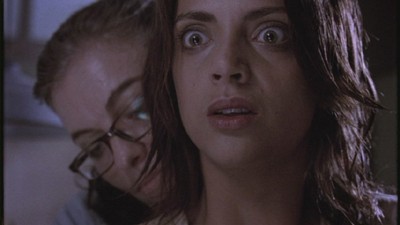
To Let (Para Entrar a Vivir)
Directed by: Jaume Balaguero
Finding the perfect apartment can be a scary series of events, especially when married or serious couples are on the search. To Let culminates on the idea that you might want to listen to your first instincts about visiting and looking further into a dilapidated apartment -- even if it's a good deal. Mario and Clara, searching for a good home to raise their upcoming child at a moderate price, drive to the hellish dilapidated outskirts of the city in search of an apartment. When they pull up to the crumbling and disgusting building, it looks very ominous for any prospects. Instantly, they're met by the suspiciously confident landlady who takes them to the upper levels of the building. Their instincts tell them to leave the place immediately, which proves to be more than just a fluttering warning about the quality of this building.
Once To Let finds its rhythm and ushers its way into the apartments, the dynamic shifts into something close to a non-hedonistic variation of Hostel. It utilizes touch-and-go successful shaky-cam photography, some which make Paul Greengrass's Bourne movies look steady, to create an unsettling and cold atmosphere as Mario and Clara struggle to make sense of the growingly unnerving landlady and her crazy antics. Through an uncomplicated premise that can almost be predicted as the film starts, To Let takes its audience through a gritty battle for two unwilling tenants to escape from a torturous and demented atmosphere. In that respect, it works well as a crass thriller meant to gives your nerves a shock or two. Jaume Balaguero's insight into the horror of placing trust into strangers becomes growingly more interesting as the time passes and we grow to learn of the landlady's reasoning, motives, and complete dementia. Though the score is underwhelming and the quaking cinematography becomes more wearisome, To Let becomes a struggle between our interest in a compelling villain's motives and the groan-worthy ignorance of two rather clueless protagonists. -- (3 / 5)
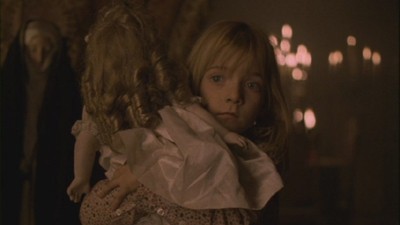
The Blame (La Culpa)
Directed by: Narcisco Ibanez Serrador
Instead of acting as much of a tension-building film, The Blame can better be looked at as a disturbingly odd anti-abortion commercial. It takes a mother, Gloria, and young daughter who struggle to pay the bills, and places them in the care of an older female gynecological doctor, Dr. Ana Torres, who seems to specialize in quick abortion procedures. She utilizes the mother's nursing talents as a way of compensating for her rent as she aids the doctor in her in-home practice. It's a strange environment for the young girl, and they try and keep her out of the affairs as much as possible. But when the mother digs a little too deep into the history behind the house and, ironically, is placed in the same decisions that her patients undergo on a daily basis, the troubled nature of the house begins to leak over into the daughter's curiosity.
The Blame never really shares its purpose of existence, only that it crafts a discomforting alternate look on what could've easily been a commonplace maternity drama. True, it works at making you feel pretty uncomfortable with Dr. Torres' disturbing past with her patients and unwarranted efforts in gaining Gloria's more "concentrated" companionship; however, it rarely gives us more than the ghastly abortion conflicts at hand. What could've been infinitely more compelling is if they had delved deeper into the history of the house and the doctor's prior failed companionships, along with some of the morality constructs lying underneath the narrative. Instead, The Blame transforms into something close to a dramatically dark and muddled message film that detracts from its potentially more interesting horror roots. It's a discomforting flick, sure, but it doesn't really make for much more than a slightly engaging and creepy character insight. In that, the efforts in crafting any dramatic or thematic tension in The Blame just fizzle out. -- (2.5 / 5)
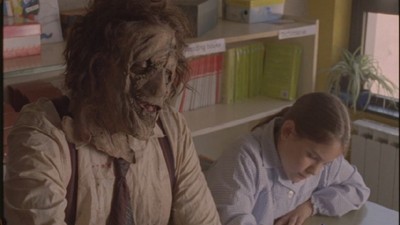
A Real Friend (Adivino Quien Soy)
Directed by: Enrique Urbizo
Put bluntly, I never could get into A Real Friend. It starts interestingly enough with a young teenage girl named Estrella who gets soaked into the world of horror movies to such a degree that she becomes "friends" with the films' monsters. She opts for their bizarre comfort instead of making friends with real people at her school, which of course doesn't raise concern in her mother until her behavior starts to shift dramatically. Their separation from the father, along with the mother's somewhat disconnected presence around her child, becomes a central theme that the more metaphysical elements of the film springboard off of. Her make-believe friends become even more tangible to her, so much that she can't even bathe or go to school without seeing the visage of a Leatherface-like figure right next to her.
However, there's not a whole lot to A Real Friend outside of some solidly-crafted make-up work and the ever-present murky insight into the confusion of a teenage girl. Estrella's wavering grasp on reality and the potential to misinterpret that becomes the central mechanism of the film, yet it never really sells us on the concepts of the physical and metaphysical in her life. Since it's a slower-paced and deliberate creepout drama, our floundering concept of her reality becomes the only reason to stick around. When it all comes to fruition at the conclusion and both realms amalgamate into one melting pot, it loses both its purpose and all grasp that we have on its plot points. Ah, but then A Real Friend pulls one last trick out of its hat - one overdone to such a degree that it almost feels like a backstab instead of a compelling climax. It didn't really grip me from the start and certainly didn't grip me at its end. -- (2 / 5)
The DVD:
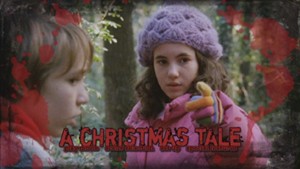
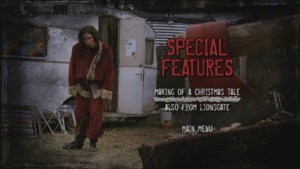
As mentioned, Lions Gate's edition of Spain's 6 Films to Keep You Awake package comes fairly stripped down in aesthetics so that it might be easier on the wallet. Presentation suffers a little bit in the process; packaged in a trayed 3-disc set, each film gets its own side of a flipper disc. Therefore, be prepared for a load of silver once you've cracked into the nicely-slipcovered presentation.
Pictured above are the menu shots for A Christmas Tale, which is the exact template (with the scattered blood glops and dots everywhere) for each of the discs. Furthermore, each disc starts with a skippable trailer for Beneath Still Waters.
The Video:
The aspect ratio for each film in the set is kept right around 1.78:1, though thin black strips can be seen on each side of several of the anamorphic images which might condense the ratio to around 1.75 or so. Visual design differs greatly between each of the pictures, from the film-like richness of The Baby's Room's cinematography to the bland fuzziness in The Blame. A fair amount of grain and digital noise can be seen in each, yet detail rarely suffers from film to film. Lions Gate has gotten rather good at presenting some solidly sharp images with little to no edge enhancement, which comes through well in each of these images. Very mild halos can be spotted along with some white speckles here and there when looked at closely, but overall we're working with six very solid transfers that retain a lot of detail and color strength.
The Audio:
Here's a very nice addition: each film receives a crisp and clean Spanish 5.1 surround track. Some of the more atmospheric points in the films utilize the rear channels more than others, like the distant thumping and screaming in To Let and the whistling of birds and rustling of leaves in A Christmas Tale. None of them, however, suffer from noticeable audio distortion or a lack of meatiness in their presentation. Though they all feel a bit like bloated stereo tracks without much three-dimensional quality, each of these six films sound suitable for their designated jobs. Optional English and Spanish subtitles are available.
The Extras:
Each film is given its own separate Making-Of Featurette which, pretty much across the board, fits the bill as a fifteen-to-twenty minute (some even a little above 20 minutes) shakedown of all the bits and pieces behind the craftsmanship of the film. All of them feature plenty of time with each film's designated director discussing their history and the passion they had behind each project. Plus, there's plenty of behind-the-scenes footage that spices up the interview / film clip formula quite well. Seeing as how we're working with a large package of films, these inclusions aren't half bad for their slightly incomprehensive nature.
-----
Final Thoughts:
Seeing as how the runtime for this entire package of films sits at 456 minutes (!), or roughly an hour and fifteen minute per film, the 6 Films to Keep You Awake packs a lot of strength for the buck. If you're sitting on $20 or so and wish to indulge in 4 solid films (A Christmas Tale, The Baby's Room, Spectre, To Let) and 2 not-so-good ones (The Blame, A Real Friend), then this collection of pseudo-short Spanish horror flicks will be money well spent. Spain's answer to the Masters of Horror brings a more domestically grounded theme to its collection, a device that's crafted to get some chills rolling along while you twitch in your couch in the middle of your home. In that, Lions Gate's competent technical package of all six films comes Recommended for a couple of nights of creepy moods that just might keep you up a little longer than expected.
PS: -- Here's the line-up that I would suggest if you are planning on running through these flicks in a solid cluster of screenings one after the other: A Christmas Story, A Real Friend, Spectre, The Baby's Room, The Blame, and To Let.
Thomas Spurlin, Staff Reviewer -- DVDTalk Reviews | Personal Blog/Site

Most of these six short films revolve around a specific kind of tension that evokes around household, or localized, terror. It makes perfect sense, especially when you take into account that the Films to Keep You Awake was originally aired as a television series. Each film's primary goal lies in making you feel like something eerie is looming around each corner of either your home or somewhere nearby. Just think of the television set as a digital campfire and the speakers of your home theater as the voice of six different storytellers. Lions Gate has brought this collection to us in a very efficient package, cutting elaborate production corners in an effort to craft a loaded, lower-priced set that will be perfect for horror film enthusiasts and completists.
The "Peliculas Para No Dormir":

A Christmas Tale (Cuento de Natividad)
Directed by: Paco Plaza
Featuring Ivana Baquero in one of her first feature roles before becoming a minor starlet in Guillermo Del Toro's Pan's Labyrinth, A Christmas Tale reflects the charm of child-based adventure horror flicks like Monster Squad and The Goonies in a darker light. After discovering the body of a dirty woman adorned in a Santa suit, the focal group of unique little children decides to keep her in that hole -- making a pact to sustain her as their "pet". They learn, however, that she is a dangerous thief who has harbored a great sum of money at an undisclosed location. As greed and morbidity start to creep into some of the children's minds, they fight between themselves to decide exactly how to handle their prisoner. It's only once they start to bite furiously at each other that they discover that their tortured prisoner has discovered a way out.
Paco Plaza's gripping little moral piece keeps a steady level of tension as the anger raging within the captured woman grows, which forms an interesting dynamic that almost wants the viewer to wish her release so that she can get a hold of the kids -- at least, the nasty ones. Each of the young actors piece together interesting little performances, especially the two evil boys. Most unique, however, is one of the more interesting villains I've seen in the evil thieving Santa-dressed woman. She becomes an ominous presence once A Christmas Tale transforms into a cat-and-mouse type of horror film, one that can be strangely rooted for and dangerous in equal strides. As the compelling twist jerks the film in a gripping direction near the end, the spliced images of a tarnished "zombie" film interlaced into A Christmas Tale come to snarky fruition. It might not be the best film in the series, but it undoubtedly has my favorite monstrous villain from the line-up. -- (3.5 / 5)

The Baby's Room (La Habitacion del Nino)
Directed by: Alexa de la Iglesia
Fitting in somewhere between the tech thriller Frequency and the Spanish horror masterwork The Orphanage, The Baby's Room indulges in an effective connection involving a haunted house and a technological abnormality that allows vision into an alternate universe. After an old baby monitor picks up some odd disturbance in the middle of the night that sounds like voices, Juan seeks a more advanced method of monitoring him and his wife Sonia's child during sleep. He comes home with the most advanced form of monitoring device with all the video surveillance bells and whistles, including infrared vision and a battery-operated screen. After they believe all their problems are solved, Juan spots something so frightening in the monitor that it sparks a downward spiral into insanity.
Perhaps the strongest flick of the bunch, The Baby's Room evokes a strong level of tension by peeking into the dangerous unknown by our modern technology. Along the way, it also tinkers with the properties of metaphysical reality and philosophical sciences. Somehow, Alexa de la Iglesia's film blends these two elements into an even stronger and oddly thoughtful pathway that leads straight into the unknown. Curiosity, insanity, and fear all come to a junction in its abyssal third act, one that'll really get your goosebumps going. Substantial performances and the fantastic architecture of this simple yet chilling ghost story barrel along to a whopper of a conclusion, one that'll really keep your head scratching once it makes sense -- well, at least as much sense as it can make. -- (3.5 / 5)

Spectre (Regreso a Moira)
Directed by: Mateo Gil
Imagine Cinema Paradiso ... only instead of an aged man returning to a movie theater from his past, he returns to try and find a hell-bent witch that he had an affair with when he was a teenager. That's Spectre, a somewhat well-performed mystery drama filled with spooky mannerisms within its dusty sepia photography. It focuses on Tomas' memories of him and two of his friends as they decide to go and spy on the local harlot Moira, a sumptuous woman believed to be a bewitching mystic. Through chance and understanding of her questionable background, Tomas somehow ends up twirling together with the shunned woman in a torrid affair. But when the townspeople's anger begins to grow and jealousy rustles between the boys as Tomas distances himself further from his town, tempers and curiosities flare up into a heated conflict.
As a fan of Asian horror, I'm accustomed to the supernatural drama flavor of film; bearing that in mind, Mateo Gil's Spectre isn't half bad. It twiddles around with the discomfort of a young boy playing with an older woman, as well as his uncertainty regarding her "magical" gift. She leaves the nights open for her witchy activities, which become the focal eerie subject that drives Tomas mad. But there's a lot of weighty build-up to Spectre's conclusion, all of which leaves you waiting to see where the horror elements will really kick into gear in this pseudo-passionate story that's supposed to "keep you awake" with the promise of a ghastly figure. When these elements arise, they're fairly anticlimactic and deflate a lot of the creepiness with their nonsensicalities -- though, they're both still a sustaining yet odd wrap-up to a competently conducted ghost story. The story's title itself instills the idea of a spectre, yet we only see that element unravel in its final dizzying moments. -- (3 / 5)

To Let (Para Entrar a Vivir)
Directed by: Jaume Balaguero
Finding the perfect apartment can be a scary series of events, especially when married or serious couples are on the search. To Let culminates on the idea that you might want to listen to your first instincts about visiting and looking further into a dilapidated apartment -- even if it's a good deal. Mario and Clara, searching for a good home to raise their upcoming child at a moderate price, drive to the hellish dilapidated outskirts of the city in search of an apartment. When they pull up to the crumbling and disgusting building, it looks very ominous for any prospects. Instantly, they're met by the suspiciously confident landlady who takes them to the upper levels of the building. Their instincts tell them to leave the place immediately, which proves to be more than just a fluttering warning about the quality of this building.
Once To Let finds its rhythm and ushers its way into the apartments, the dynamic shifts into something close to a non-hedonistic variation of Hostel. It utilizes touch-and-go successful shaky-cam photography, some which make Paul Greengrass's Bourne movies look steady, to create an unsettling and cold atmosphere as Mario and Clara struggle to make sense of the growingly unnerving landlady and her crazy antics. Through an uncomplicated premise that can almost be predicted as the film starts, To Let takes its audience through a gritty battle for two unwilling tenants to escape from a torturous and demented atmosphere. In that respect, it works well as a crass thriller meant to gives your nerves a shock or two. Jaume Balaguero's insight into the horror of placing trust into strangers becomes growingly more interesting as the time passes and we grow to learn of the landlady's reasoning, motives, and complete dementia. Though the score is underwhelming and the quaking cinematography becomes more wearisome, To Let becomes a struggle between our interest in a compelling villain's motives and the groan-worthy ignorance of two rather clueless protagonists. -- (3 / 5)

The Blame (La Culpa)
Directed by: Narcisco Ibanez Serrador
Instead of acting as much of a tension-building film, The Blame can better be looked at as a disturbingly odd anti-abortion commercial. It takes a mother, Gloria, and young daughter who struggle to pay the bills, and places them in the care of an older female gynecological doctor, Dr. Ana Torres, who seems to specialize in quick abortion procedures. She utilizes the mother's nursing talents as a way of compensating for her rent as she aids the doctor in her in-home practice. It's a strange environment for the young girl, and they try and keep her out of the affairs as much as possible. But when the mother digs a little too deep into the history behind the house and, ironically, is placed in the same decisions that her patients undergo on a daily basis, the troubled nature of the house begins to leak over into the daughter's curiosity.
The Blame never really shares its purpose of existence, only that it crafts a discomforting alternate look on what could've easily been a commonplace maternity drama. True, it works at making you feel pretty uncomfortable with Dr. Torres' disturbing past with her patients and unwarranted efforts in gaining Gloria's more "concentrated" companionship; however, it rarely gives us more than the ghastly abortion conflicts at hand. What could've been infinitely more compelling is if they had delved deeper into the history of the house and the doctor's prior failed companionships, along with some of the morality constructs lying underneath the narrative. Instead, The Blame transforms into something close to a dramatically dark and muddled message film that detracts from its potentially more interesting horror roots. It's a discomforting flick, sure, but it doesn't really make for much more than a slightly engaging and creepy character insight. In that, the efforts in crafting any dramatic or thematic tension in The Blame just fizzle out. -- (2.5 / 5)

A Real Friend (Adivino Quien Soy)
Directed by: Enrique Urbizo
Put bluntly, I never could get into A Real Friend. It starts interestingly enough with a young teenage girl named Estrella who gets soaked into the world of horror movies to such a degree that she becomes "friends" with the films' monsters. She opts for their bizarre comfort instead of making friends with real people at her school, which of course doesn't raise concern in her mother until her behavior starts to shift dramatically. Their separation from the father, along with the mother's somewhat disconnected presence around her child, becomes a central theme that the more metaphysical elements of the film springboard off of. Her make-believe friends become even more tangible to her, so much that she can't even bathe or go to school without seeing the visage of a Leatherface-like figure right next to her.
However, there's not a whole lot to A Real Friend outside of some solidly-crafted make-up work and the ever-present murky insight into the confusion of a teenage girl. Estrella's wavering grasp on reality and the potential to misinterpret that becomes the central mechanism of the film, yet it never really sells us on the concepts of the physical and metaphysical in her life. Since it's a slower-paced and deliberate creepout drama, our floundering concept of her reality becomes the only reason to stick around. When it all comes to fruition at the conclusion and both realms amalgamate into one melting pot, it loses both its purpose and all grasp that we have on its plot points. Ah, but then A Real Friend pulls one last trick out of its hat - one overdone to such a degree that it almost feels like a backstab instead of a compelling climax. It didn't really grip me from the start and certainly didn't grip me at its end. -- (2 / 5)
The DVD:


As mentioned, Lions Gate's edition of Spain's 6 Films to Keep You Awake package comes fairly stripped down in aesthetics so that it might be easier on the wallet. Presentation suffers a little bit in the process; packaged in a trayed 3-disc set, each film gets its own side of a flipper disc. Therefore, be prepared for a load of silver once you've cracked into the nicely-slipcovered presentation.
Pictured above are the menu shots for A Christmas Tale, which is the exact template (with the scattered blood glops and dots everywhere) for each of the discs. Furthermore, each disc starts with a skippable trailer for Beneath Still Waters.
The Video:
The aspect ratio for each film in the set is kept right around 1.78:1, though thin black strips can be seen on each side of several of the anamorphic images which might condense the ratio to around 1.75 or so. Visual design differs greatly between each of the pictures, from the film-like richness of The Baby's Room's cinematography to the bland fuzziness in The Blame. A fair amount of grain and digital noise can be seen in each, yet detail rarely suffers from film to film. Lions Gate has gotten rather good at presenting some solidly sharp images with little to no edge enhancement, which comes through well in each of these images. Very mild halos can be spotted along with some white speckles here and there when looked at closely, but overall we're working with six very solid transfers that retain a lot of detail and color strength.
The Audio:
Here's a very nice addition: each film receives a crisp and clean Spanish 5.1 surround track. Some of the more atmospheric points in the films utilize the rear channels more than others, like the distant thumping and screaming in To Let and the whistling of birds and rustling of leaves in A Christmas Tale. None of them, however, suffer from noticeable audio distortion or a lack of meatiness in their presentation. Though they all feel a bit like bloated stereo tracks without much three-dimensional quality, each of these six films sound suitable for their designated jobs. Optional English and Spanish subtitles are available.
The Extras:
Each film is given its own separate Making-Of Featurette which, pretty much across the board, fits the bill as a fifteen-to-twenty minute (some even a little above 20 minutes) shakedown of all the bits and pieces behind the craftsmanship of the film. All of them feature plenty of time with each film's designated director discussing their history and the passion they had behind each project. Plus, there's plenty of behind-the-scenes footage that spices up the interview / film clip formula quite well. Seeing as how we're working with a large package of films, these inclusions aren't half bad for their slightly incomprehensive nature.
-----
Final Thoughts:
Seeing as how the runtime for this entire package of films sits at 456 minutes (!), or roughly an hour and fifteen minute per film, the 6 Films to Keep You Awake packs a lot of strength for the buck. If you're sitting on $20 or so and wish to indulge in 4 solid films (A Christmas Tale, The Baby's Room, Spectre, To Let) and 2 not-so-good ones (The Blame, A Real Friend), then this collection of pseudo-short Spanish horror flicks will be money well spent. Spain's answer to the Masters of Horror brings a more domestically grounded theme to its collection, a device that's crafted to get some chills rolling along while you twitch in your couch in the middle of your home. In that, Lions Gate's competent technical package of all six films comes Recommended for a couple of nights of creepy moods that just might keep you up a little longer than expected.
PS: -- Here's the line-up that I would suggest if you are planning on running through these flicks in a solid cluster of screenings one after the other: A Christmas Story, A Real Friend, Spectre, The Baby's Room, The Blame, and To Let.
|
| Popular Reviews |
| Sponsored Links |
|
|
| Sponsored Links |
|
|
| Release List | Reviews | Shop | Newsletter | Forum | DVD Giveaways | Blu-Ray | Advertise |
|
Copyright 2024 DVDTalk.com All Rights Reserved. Legal Info, Privacy Policy, Terms of Use,
Manage Preferences,
Your Privacy Choices | |||||||









